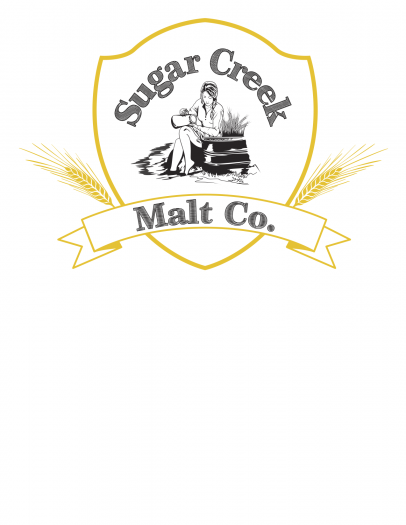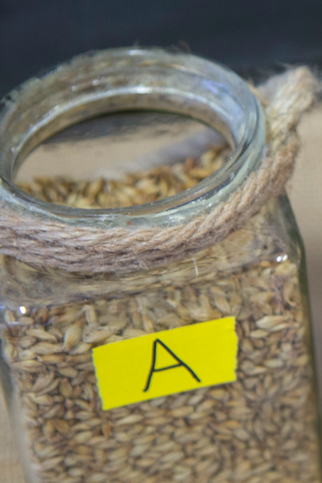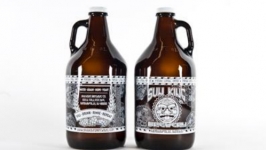Sugar Creek Malt Co., Where Chit is King
The rain this June and July in Central Indiana was exhausting. Those of us in the area spent a large portion of our time spying for sunrays in the horizon and shaking our wind-battered umbrellas free of raindrops. So as I sat and watched the deluge drown my idea of summer, I hoped it wouldn’t rear its ugly head on July 16. This was Sugar Creek Malt Co.’s field day and open house in Lebanon. Edible Indy had been invited and the excitement was building.
Why so much excitement? That’s where the affable Michalkes (pronounced like Milwaukee) come onto the scene with their contagious enthusiasm. Jim and Heather Michalke, along with their son, Caleb, and daughter-in-law, Whitney, have undertaken a venture lost in Indiana’s yesteryear: malting.
You might ask how this all came about. Jim is a hog and row-crop farmer in Lebanon, and his wife, Heather, assimilated to country life after being raised on the south side of Chicago, so Caleb grew up with the agriculture bug. He earned his degree from Purdue and taught for a couple of years before determining it wasn’t his path. Two years ago, the four family members came up with the concept of a farm focused on growing grains that could then be malted on location. One year ago they started cultivating that idea, and now here they are—providing “local malt for local beer” out of a retrofitted barn in Lebanon.
But don’t be fooled … it didn’t come easy.
Wanting to dive into farming and malting grains, Caleb couldn’t get the information he needed locally (remember, yesteryear was a while ago). That’s when Caleb’s education began, which took him to North Dakota and Winnipeg. There he learned about moisture, time, temperature, types of brew, enzymes—all of the magic that goes into malting for craft brew.
Armed with education and determination, Sugar Creek Malt Co. became a reality earlier this year and according to the Michalkes has now entered the field of only 50 craft malt houses throughout the nation.
And on July 16, on a sparsely clouded, sunny summer day Central Indiana souls had been starving for, Sugar Creek Malt Co. had its open house.
During the event, guests were treated to a tour of the facility and an explanation of the careful process the grain, like barley, goes through before it fills its purpose of becoming part of “small batches of malt for craft breweries,” according to Caleb.
Amongst the guests were some of the 11 farmers throughout Indiana, Kentucky and Ohio, all within a 200 miles radius, Sugar Creek has contracted with to grow 200 acres of grains. (The Michalkes are personally growing 20 acres of barley, 20 acres of wheat and 20 acres of rye.) These farmers are a proud and necessary part of a local circle of life—from field to malt house to brewery. One farmer even leaned down with me to hold a piece of barley in her hand and point out the difference between two- versus six-row varieties. And while only 100–150 of this year’s planted acres can be used—back to that pesky rain that drenched Indiana early summer—looking forward Sugar Creek hopes to increase this number to 400 acres.
So what exactly is the malting process? It begins with placing the grain, let’s say barley here, in storage tanks. From there, it’s moved for cleaning to a 1948 Clipper machine, which has been totally restored and, according to Whitney “separates the bad from the good.” Then, the barley is soaked in a steep tank for 2–3 days in a germination room. During this time, each piece of tiny barley goes through an important metamorphosis—this is when chitting happens.
“Chitting is a very important part of the malting process.” Caleb told those of us on the tour looking to see exactly what that meant and seeing each piece of barley sprouting what looked like a little threaded tail out of one end.
And once the chitting occurs, those little barley bits are sent to germinate further on a pneumatic germ floor or on a malting floor for approximately four days. And germination is a tricky business, according to Caleb, as they analyze each batch to ensure quality.
After germinating, the chit-sprouting barley is dried in a machine special ordered from the East Coast, and based off of tobacco drying machine technology, because small-scale malting equipment is not easy to find. After installation, and a tweak or two from the company that installed it and a local individual who definitely had a learning curve, the result is only about a five point temperature differential, which according to Caleb is the key to good drying.
Then, the barley is placed into a machine that “debeards” each piece—bye bye chit!—then it’s cleaned one last time before being bagged and stored. The end destination of this malted goodness produced up to two tons at a time involves craft brew.
There are four barley varieties currently in production at Sugar Creek: Scarlett, a German variety that produces traditional German malts; Conlon, a plump North American variety that will give brewers really high-extract yields; Full Pint, a variety specifically developed for the craft brewing industry for its flavor; and Thoroughbred, which is Sugar Creek’s only six-row with lineage from French malting varieties and is good for Belgian-style ales. They also have two rye varieties, a red wheat and, hopefully in the near future, spelt, which provides a nutty flavor for beers; buckwheat, which is gluten-free; and oats, which add thickness and foam retention in beer.
Right now, Sugar Creek Malt Co. is working on what they call several base malts out of their two-row varieties—pilsner, pale ale, Vienna and Munich. They are also “playing around with the six-row variety and making some darker, more flavorful six-row malts,” Caleb said.
As if that wasn’t enough to get your taste buds going, by the end of the year this one-of-a-kind Indiana business hopes to have their roasting and smoking facility up and running to offer a line of smoked malts showcasing the range of flavors barley offers.
One of the last remaining questions for beer geeks and neophytes remains: How does the malt taste when brewed? At the open house, Great Crescent Brewery (Aurora) was pouring beer made with Sugar Creek’s malt. I think those that gave it a try would agree—local through and through never tasted so good.








